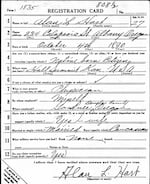It was 105 years ago that an Oregon doctor underwent what is thought to be the first documented gender-confirming surgery in the United States.
Dr. Alan Hart was born Alberta “Lucille” Hart in 1890. Hart grew up in the Willamette Valley and attended Albany College, now Lewis & Clark College. Hart preferred to present as male and did so as much as possible – often with family support. But at school, Hart was forced to wear dresses and appear as “Lucille.”
In 1917, Hart graduated with a medical degree from the University of Oregon Medical Department in Portland, now Oregon Health & Science University. That same year, Hart persuaded fellow Oregon doctor J. Allen Gilbert to perform what was — at the time —considered an unheard-of transition surgery. Hart underwent a hysterectomy, ensuring Hart could not have menses or become pregnant. That operation, along with a psychological evaluation, was enough for Dr. Gilbert to officially state that Hart should be accepted by society as a man.
“— Dr. J Allen GilbertFrom a sociological and psychological standpoint, she is a man. If society will but let her alone, she will fill her niche in the world and leave it better for her bravery.”
Gilbert reported in a medical journal, “A hysterectomy was performed, her hair was cut, a complete male outfit was secured. She made her exit as a female and started as a male with a new hold on life.”

Alan Hart, circa 1922
Gay & Lesbian Archives of the Pacific Northwest
Within months of the surgery and transition, Hart legally changed his name and eloped with Portland schoolteacher Inez Stark. At the time, so-called “cross dressing” and same-sex marriage were illegal. Despite the risks, Hart came out openly in his hometown of Albany.
In 1918, Hart told the Albany Daily Democrat, “I had to do it. ... For years, I had been unhappy. With all the inclinations and desires of the boy. ... I have been happier since I made this change than I ever have in my life, and I will continue this way as long as I live. Very few people can understand.”
Many people didn’t understand. Throughout his career, he was outed and harassed, forcing him to move and change practices. His first marriage ended under that strain. Eventually, he married again and changed his career focus, graduating with a master’s degree in public health from Yale University. He would rise to the top of his field in treating and studying tuberculous. His pioneering work using x-rays for early detection is credited with saving thousands of lives.

Alan Hart's draft registration card.
public domain / Lewis & Clark College, Special Collections, Dr Alan L. Hart Collection
When Dr. Alan Hart died in 1962, his will instructed his attorney to destroy all of his personal papers, photographs, and records. Researchers rediscovered his story in the 1970s, but it remains largely unknown.
A compilation of Alan Hart’s college writings, along with an overview of Hart’s life, can be found online in the Lewis & Clark College Special Collections.
